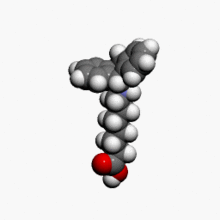Amineptin
Amineptin je organsko jedinjenje, koje sadrži 22 atoma ugljenika i ima molekulsku masu od 373,916 Da.[1][2][3][4][5][6][7]
 | |
 | |
| Klinički podaci | |
|---|---|
| Prodajno ime | Maneon, Survector |
| Drugs.com | Monografija |
| Farmakokinetički podaci | |
| Poluvreme eliminacije | 48 minuta |
| Identifikatori | |
| CAS broj | 57574-09-1 |
| ATC kod | N06AA19 (WHO) |
| PubChem | CID 34869 |
| DrugBank | DB04836 |
| ChemSpider | 32090 |
| ChEBI | CHEBI:32499 |
| ChEMBL | CHEMBL418995 |
| Hemijski podaci | |
| Formula | C22H28ClNO2 |
| Molarna masa | 373,916 |
| |
| |
Osobine
уреди| Osobina | Vrednost |
|---|---|
| Broj akceptora vodonika | 2 |
| Broj donora vodonika | 2 |
| Broj rotacionih veza | 8 |
| Particioni koeficijent[8] (ALogP) | 1,1 |
| Rastvorljivost[9] (logS, log(mol/L)) | -7,0 |
| Polarna površina[10] (PSA, Å2) | 92,4 |
Reference
уреди- ^ Vaugeois JM, Corera AT, Deslandes A, Costentin J: Although chemically related to amineptine, the antidepressant tianeptine is not a dopamine uptake inhibitor. Pharmacol Biochem Behav. 1999 Jun;63(2):285-90. PMID 10371658
- ^ Grupper C: [New iatrogenic acne: acne caused by amineptin (Survector)] Ann Dermatol Venereol. 1988;115(11):1174-6. PMID 2977079
- ^ Thioly-Bensoussan D, Charpentier A, Triller R, Thioly F, Blanchet P, Tricoire N, Noury JY, Grupper C: [Iatrogenic acne caused by amineptin (Survector). Apropos of 8 cases] Ann Dermatol Venereol. 1988;115(11):1177-80. PMID 2977080
- ^ Vexiau P, Gourmel B, Husson C, Castot A, Rybojad M, Julien R, Fiet J, Puissant A, Cathelineau G: [Severe lesions of acne type induced by chronic amineptin poisoning: apropos of 6 cases] Ann Dermatol Venereol. 1988;115(11):1180-2. PMID 2977081
- ^ Teillac D, Weber MJ, Lowenstein W, de Prost Y: [Acne caused by Survector] Ann Dermatol Venereol. 1988;115(11):1183-4. PMID 2977082
- ^ Knox C, Law V, Jewison T, Liu P, Ly S, Frolkis A, Pon A, Banco K, Mak C, Neveu V, Djoumbou Y, Eisner R, Guo AC, Wishart DS (2011). „DrugBank 3.0: a comprehensive resource for omics research on drugs”. Nucleic Acids Res. 39 (Database issue): D1035—41. PMC 3013709 . PMID 21059682. doi:10.1093/nar/gkq1126.
- ^ David S. Wishart; Craig Knox; An Chi Guo; Dean Cheng; Savita Shrivastava; Dan Tzur; Bijaya Gautam; Murtaza Hassanali (2008). „DrugBank: a knowledgebase for drugs, drug actions and drug targets”. Nucleic acids research. 36 (Database issue): D901—6. PMC 2238889 . PMID 18048412. doi:10.1093/nar/gkm958.
- ^ Ghose, A.K.; Viswanadhan V.N. & Wendoloski, J.J. (1998). „Prediction of Hydrophobic (Lipophilic) Properties of Small Organic Molecules Using Fragment Methods: An Analysis of AlogP and CLogP Methods”. J. Phys. Chem. A. 102: 3762—3772. doi:10.1021/jp980230o.
- ^ Tetko IV, Tanchuk VY, Kasheva TN, Villa AE (2001). „Estimation of Aqueous Solubility of Chemical Compounds Using E-State Indices”. Chem Inf. Comput. Sci. 41: 1488—1493. PMID 11749573. doi:10.1021/ci000392t.
- ^ Ertl P.; Rohde B.; Selzer P. (2000). „Fast calculation of molecular polar surface area as a sum of fragment based contributions and its application to the prediction of drug transport properties”. J. Med. Chem. 43: 3714—3717. PMID 11020286. doi:10.1021/jm000942e.
Literatura
уреди- Hardman JG, Limbird LE, Gilman AG (2001). Goodman & Gilman's The Pharmacological Basis of Therapeutics (10. изд.). New York: McGraw-Hill. ISBN 0071354697. doi:10.1036/0071422803.
- Thomas L. Lemke; David A. Williams, ур. (2007). Foye's Principles of Medicinal Chemistry (6. изд.). Baltimore: Lippincott Willams & Wilkins. ISBN 0781768799.
Spoljašnje veze
уреди
| Molimo Vas, obratite pažnju na važno upozorenje u vezi sa temama iz oblasti medicine (zdravlja). |